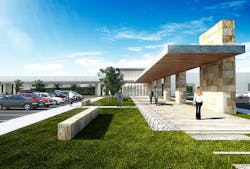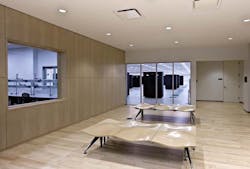Where data centers meet design
“How do you get excited about designing a space that’s for machines and not for people?”
I’ll never forget being asked that question years ago at the end of a presentation about a data center project. It’s a valid question about what it means to be an architect for data centers – buildings that are typically considered more engineering-focused than design-focused.
Here are three ways Gensler proves that our role as an architect is essential to the successful design of data centers:
Future-Proof & Flexible
As technology continues to evolve, we have to simultaneously adapt and help our clients think beyond the short term. As we design, we can’t just look at our client’s current or near-future needs. We have to take into account their needs for far-future growth and flexibility as well, ensuring their facilities are future-proof.
We help our clients to be nimble in accommodating inevitable future technology changes. By thinking ahead about the challenges our clients could face, we are able to develop building solutions that can address flexibility concerns early on. For instance:
- How do you master plan a site today for smart future growth?
- What if your next major IT deployment is containerized?
- What if improvement in server technology allows for a reduction in or elimination of mechanical refrigeration?
- What if future electrical systems are modularized?
- How do you provide infrastructure today for future expansion without unnecessarily over-building?
This thinking is critical in guiding our clients through the design process.
Wayfinding & Safety
A data center can be much like a labyrinth. It can be very large and on one floor (maybe two) with corridors that contain door after door, room after room. It can easily start to blend together. During urgent events, you can imagine the potential for error if responders struggle to accurately locate rooms or equipment.
Through design, we aim to organize and plan these facilities logically to help reduce human error, thus reducing the amount of time the facility is down. In addition to thoughtful planning, we use graphic elements, color and other visual indicators that assist in wayfinding. We look at every surface in the space as an opportunity for graphic, labeling or visual cues to help increase situational awareness so responders can focus on finding a resolution instead of trying to find the problem. We also try to ensure that equipment rooms with identical functions are identically planned and properly labeled to maintain consistency of function throughout the facility.
A data center can also be thought of as a data factory. Though there may not be constant movement on the inside, like a traditional factory, heavy equipment is routinely transported throughout the facility. There are situations where the movement of equipment and the movement of people can be in conflict. To accommodate for safety, we design wider corridors, create designated zones for equipment and people, add visual cues in areas where employees need to take caution, and plan around movement of equipment to and from critical locations throughout the facility.
Process & Experience
To start, everything we design involves two facets - process and experience. Our job as architects and designers is to find a balance of the two, giving our clients spaces that facilitate their process but also create an experience for their end users.
Data center design, however, has traditionally been process-focused, with experience landing further down on the list of priorities. The buildings were anonymous, and they received no visitors aside from employees. That’s just the way it was. Over the last several years, that began to change. Our clients began understanding the value in providing an experience.
As data centers have become more known to the public, some clients have embraced the idea of showcasing their facilities through tours. It’s truly a 180-degree shift from the old way of thinking about these spaces. Now more than ever, clients not only want to let people into their facilities, but they want to guide them through the building to share what they do and why they do it. They are taking their mission and turning it into an experience. Even the decidedly un-tech-centric fashion world is taking notice. Chanel’s Karl Lagerfeld turned his 2016 Paris Fashion Week runway into a data center.
Naturally, there are parts of every data center that remain off-limits, so the trick is creating physical visibility for visitors without allowing physical access. You wouldn’t want a school field trip to accidentally end up in your computer rooms, right? We take that into account through design by carving out tour zones that won’t interrupt workflow. We include windows or floor-to-ceiling glass so visitors can see into the action while limiting their access. Coupling these dedicated zones with visual cues, branding, graphics or video content allows tours and employees to simultaneously function in the space. The visual and interactive content of these tours not only conveys our clients’ mission and message to outsiders, but also to their employees who experience the space.
Speaking of employees, let’s not forget that data centers are workplaces, too! They often include traditional workplace environments and associated amenities for front office functions, which are certainly in our wheelhouse as the world’s #1 workplace design firm.
Our expertise, knowledge and commitment to our clients’ goals all contribute to Gensler, as an architect, designing data centers that facilitate both process and experience objectives. Through design, we help our clients accomplish their mission - whether that is to connect the world, treat and cure diseases, predict disasters, find energy, protect citizens, facilitate global commerce, provide digital content or, in so many other ways, improve lives around the world.
How can you not get excited about that?
Gensler was recently named the #1 Data Center Architecture Firm for the third year in a row.

